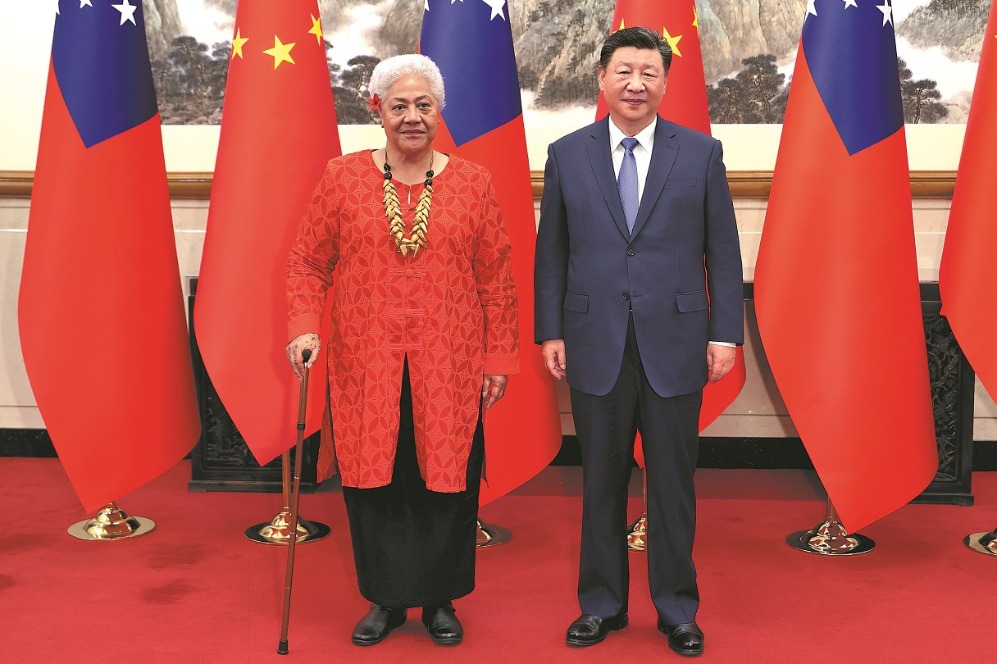Soft rebound paves way for policy transformation


As the Chinese economy moves toward a soft rebound, it may launch large-scale fiscal and tax reforms to facilitate and boost growth for years to come.
Citing a Japanese "financial journalist", US-based Newsweek recently reported that "China's economy not only expanded less than reported but also contracted in 2023". Apparently, Newsweek thought it had a scoop. Stunningly, dismissing all the growth figures of China by global development banks, the Newsweek report relied on Tamura Hideo of Sankei Shimbun that represents Japan's ultra-nationalist far-right.
It was déjà vu all over again. Last summer, when Shanghai began to rebound, Newsweek reported that it had turned into a "ghost town". Then its economic authority was a geopolitical hitman, who recently popped up again at a Texas border rally blaming the Hispanic migrants, based on conspiracy theories, for the United States' problems, according to the very same Newsweek. There is a pattern of methodical obfuscation among the leading global media outlets. Economic reporting is increasingly subject to geopolitical agendas.
However, without substantial official support to boost consumption, consumption growth would likely be moderate in 2024 given the current outlook on real estate and confidence. Hence, the impending push for a proactive fiscal policy, coupled with a new round of fiscal and tax reform, to boost consumption growth. Recently, this was coupled with the biggest-ever cut to the key mortgage rate by China's central bank, to bolster the housing market.
Despite the real estate downturn, China met its economic growth target last year. With economic growth of 5.2 percent year-on-year, fiscal revenue exceeded $2.9 trillion last year, an increase of 6.4 percent from the previous year.
In 2012, as part of the overall plan of deepening reform, China embarked on a journey to establish a modern public finance system. In the past decade, the fiscal and tax reform has been gradually moving toward a reformed system. These efforts are garnering greater momentum now, as evidenced by the key economic priorities of the Central Economic Work Conference in December.
Since January, there has been increasing global interest in China's reform efforts, in particular its rethinking of the incentives it gives its local governments to support the economy.
In the past more than four decades, China's impressive growth record has dramatically improved Chinese people's living standards and eradicated extreme poverty. But like in other industrializing countries, China's growth has been accompanied by widening imbalances. The current challenges have their origin in the 2008-09 Chinese economic stimulus package of $586 billion — whose aim was to minimize the impact of the US subprime crisis-induced global financial crisis.
The stimulus did boost growth, helping the Chinese economy to recover from 6 percent to over 10 percent by mid-2009, and drive 50 percent of global growth, thus supporting the ailing West. But the stimulus also contributed to a great surge in local government debt. In particular, investment in infrastructure and housing fostered rising debt among property developers, local governments and local government financing vehicles.
Over the medium term, the goal of the impending fiscal policy reform is to improve the risk-sharing mechanisms between the central government and the local governments, to close the fiscal gaps at the local level and reduce local governments' dependency on the sale of land-use rights, as the International Monetary Fund recently said.
The effort at fiscal consolidation is based on the reduction of off-budget investment and the execution of broad social security and tax reforms, including greater reliance on personal income tax, to foster equity.
After three years of deleveraging in the ailing property sector, the Chinese economy is moving toward a soft landing in 2024 and normalization by 2025. But China is neither Japan of the 1990s nor the US of 2008-09. Despite large-scale deleveraging in the sector, homebuyers in China are actually leveraging up, as Singaporean multinational bank, DBS Bank, has reported.
In other words, Chinese consumers do not lack purchasing power. They are able to spend, and increase their spending. But being cost-conscious, they have been cautious to do so, consuming moderately and saving excessively.
Moreover, there is a great need for broad structural reforms and adequate support to cushion the impact of the adjustment in the property sector — and to unleash the pent-up consumption capacity.
China's structural potential remains high. In the West, the middle-class's real income has stagnated for four decades. In China, there are 400 million people in the middle-income group, and their number could double to 800 million in the next decade. And urbanization will likely create huge demand in sectors such as housing, education, medical and elderly care.
By 2030 an additional 240 million rural residents in China could migrate to cities. Among other things, that will translate to great secular potential for investments to upgrade urban transportation and telecom infrastructure. That means a substantial opportunity for domestic and global financial institutions.
By contrast, in the West, trade wars and geopolitics, coupled with xenophobia and unwarranted wars, have proved to be a costly distraction from requisite structural reforms in home markets.
What the world economy needs is successful growth transformation in China — and large-scale economic reforms within rather than futile foreign interventions by the West.
The author is the founder of Difference Group and has served at the India, China and America Institute (US), Shanghai Institute for International Studies (China) and the EU Centre (Singapore). The views don't necessarily reflect those of China Daily.
If you have a specific expertise, or would like to share your thought about our stories, then send us your writings at opinion@chinadaily.com.cn, and comment@chinadaily.com.cn.


































